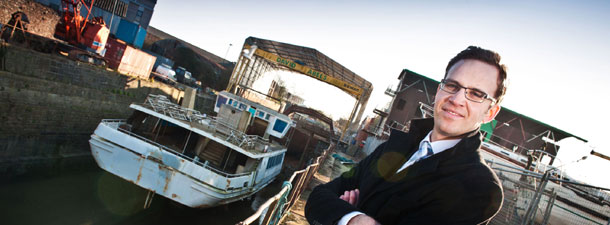A key stretch of Bristol’s historic Portway from the Clifton Suspension Bridge to the Cumberland Basin has become a no-go area for everybody except motorists and lorry drivers and is crying out for an immediate makeover if its rich history is to be preserved.
That’s according to Colliers International planning specialist James Edwards who said the Portway metamorphoses from beautyspot to backwater within a stone’s throw of some of the finest heritage sites in the city.
The leading planning and maritime heritage expert urged Bristol City Councilors, planners and stakeholders to give the gateway urgent consideration when deciding future transport priorities as part of the Central Area Action Plan – due to be finalised next month.
James Edwards said: “The stretch of the A4 Portway from the Clifton Suspension Bridge into Hotwells and the Cumberland Basin is an eyesore that must be sorted out if Bristol is to fully embrace its heritage and be considered a first rate city on the European stage.
“At the moment it’s a road to nowhere, turning from world renowned beautyspot to backwater within a mile. It is long overdue a rethink if the city is to capitalise on the fantastic heritage opportunities along this short but highly important stretch of road.”
Based at Colliers International’s Broad Quay office, James Edwards is fast becoming one of the leading authorities on Bristol’s maritime and industrial heritage. He said it was sad the area’s historical importance had been all but forgotten.
“The Portway here has quite literally lost its way. This stretch of the A4 has been consumed by concrete and flyovers while the fantastic built heritage including the Clifton Rocks Railway and the fine terraces and crescents all around – have been forgotten and left to decay.
“Until now, the city council’s emphasis seems to have been concentrated further along toward the harbourside. The Portway is one of the main routes into the city and demands a great deal more sympathetic attention than it has received during the decades since the war.”
Hotwells was a major social hub from the 17th to the 19th century with the development of the Hotwell Spring, a spa facility on the River Avon to rival Bath Spa, along with the Clifton Rocks Railway which transported people to the Spa from Clifton.
The Portway had its own railway station, a dedicated tram line into the city and fine promenades including St Vincent’s Parade and St Vincent’s Terrace.
James Edwards said although the spa facilities may have gone there was still time to preserve and restore the area’s rich history and heritage.
He said he fully supported Bristol City Council’s Central Area Action Plan which outlines a number of proposals aimed at improving the public realm around the Cumberland Basin including upgraded cycle and walkways, removing the approach ramp to the multi-level Macadam Way and creating a softer landscape with improved opportunities for community leisure and biodiversity.
He concluded: “Whilst we may not be able to do much to the Cumberland Basin without huge cost and logistical difficulties, we could realistically manage the use of the available space leading up to the Cumberland Basin along the A4 Portway, improving the pedestrian walkways and reducing the excessive road widths to provide more space for walking and cycling.
“It would be great if the stretch could be improved to win back the public realm from the motor car and allow Bristolians to come and enjoy this forgotten part of Bristol. We need to reinstate this area to its rightful position as a historic and architecturally significant area of the city rather than a grubby backwater.
“Bristolians have watched an awful lot of Hotwells disappear through ‘road improvements’ and the pressures of the motor car, let’s not lose or take for granted what we still have here on the Portway.”















